Hyundai Santa Fe 2009 Owner's Manual - RHD (UK, Australia)
Manufacturer: HYUNDAI, Model Year: 2009, Model line: Santa Fe, Model: Hyundai Santa Fe 2009Pages: 269, PDF Size: 9.78 MB
Page 251 of 269
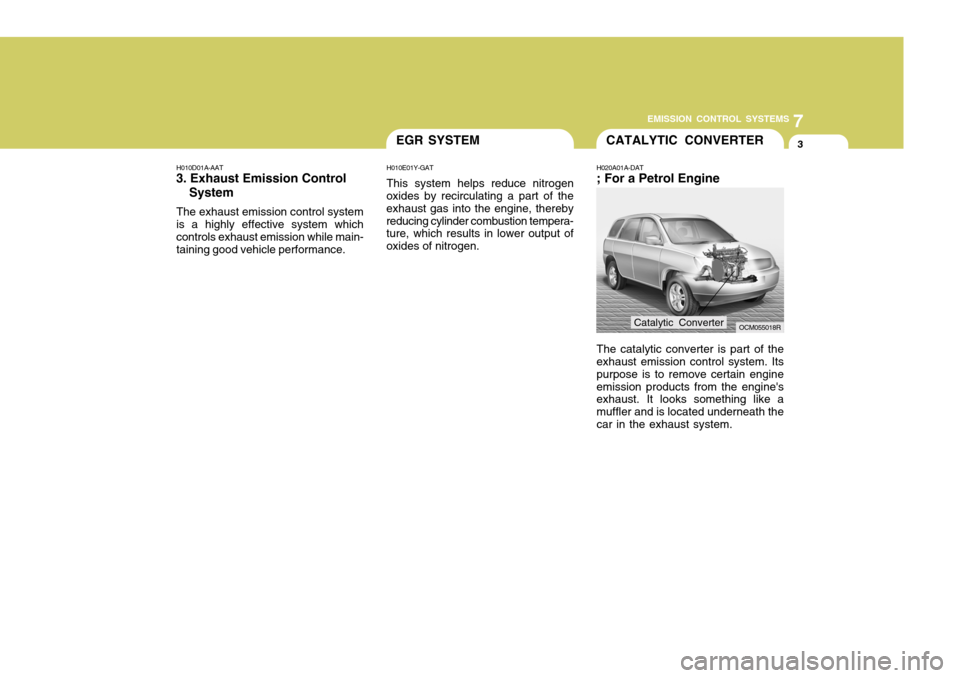
7
EMISSION CONTROL SYSTEMS
3EGR SYSTEMCATALYTIC CONVERTER
H020A01A-DAT ; For a Petrol Engine The catalytic converter is part of the exhaust emission control system. Its purpose is to remove certain engineemission products from the engine's exhaust. It looks something like a muffler and is located underneath thecar in the exhaust system.
H010D01A-AAT
3. Exhaust Emission Control
System
The exhaust emission control systemis a highly effective system which controls exhaust emission while main- taining good vehicle performance. H010E01Y-GAT This system helps reduce nitrogen
oxides by recirculating a part of the exhaust gas into the engine, therebyreducing cylinder combustion tempera- ture, which results in lower output of oxides of nitrogen.
OCM055018RCatalytic Converter
Page 252 of 269
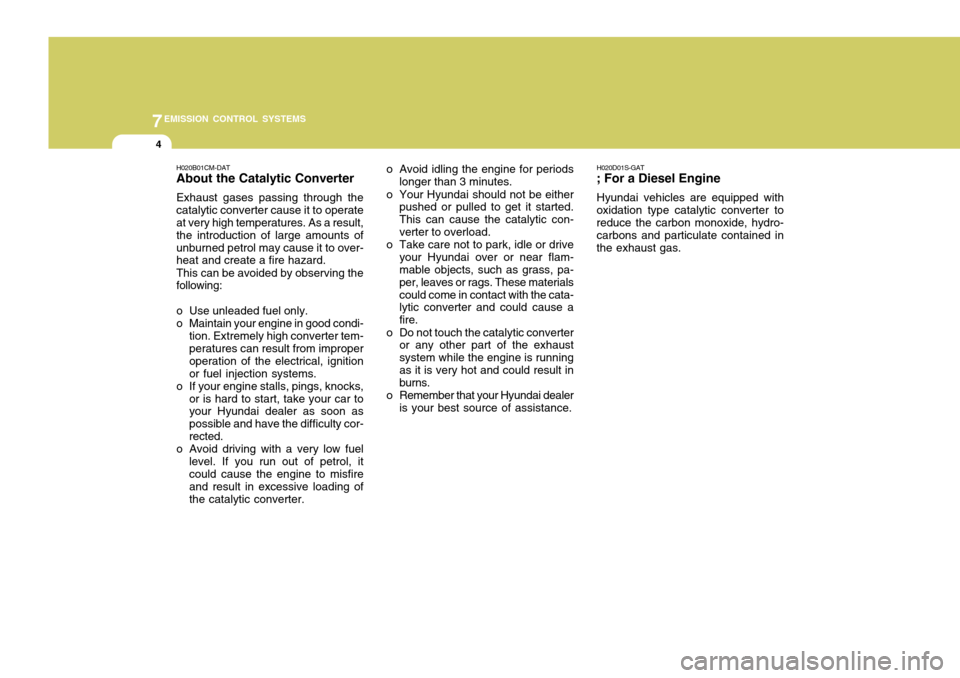
7EMISSION CONTROL SYSTEMS
4
o Avoid idling the engine for periodslonger than 3 minutes.
o Your Hyundai should not be either pushed or pulled to get it started. This can cause the catalytic con-verter to overload.
o Take care not to park, idle or drive your Hyundai over or near flam- mable objects, such as grass, pa- per, leaves or rags. These materialscould come in contact with the cata- lytic converter and could cause a fire.
o Do not touch the catalytic converter or any other part of the exhaustsystem while the engine is runningas it is very hot and could result in burns.
o Remember that your Hyundai dealer is your best source of assistance.
H020B01CM-DAT About the Catalytic Converter Exhaust gases passing through the catalytic converter cause it to operate at very high temperatures. As a result, the introduction of large amounts ofunburned petrol may cause it to over- heat and create a fire hazard. This can be avoided by observing the following:
o Use unleaded fuel only.
o Maintain your engine in good condi-
tion. Extremely high converter tem- peratures can result from improper operation of the electrical, ignitionor fuel injection systems.
o If your engine stalls, pings, knocks, or is hard to start, take your car to your Hyundai dealer as soon as possible and have the difficulty cor-rected.
o Avoid driving with a very low fuel
level. If you run out of petrol, itcould cause the engine to misfire and result in excessive loading of the catalytic converter. H020D01S-GAT
; For a Diesel Engine
Hyundai vehicles are equipped with
oxidation type catalytic converter to reduce the carbon monoxide, hydro- carbons and particulate contained inthe exhaust gas.
Page 253 of 269
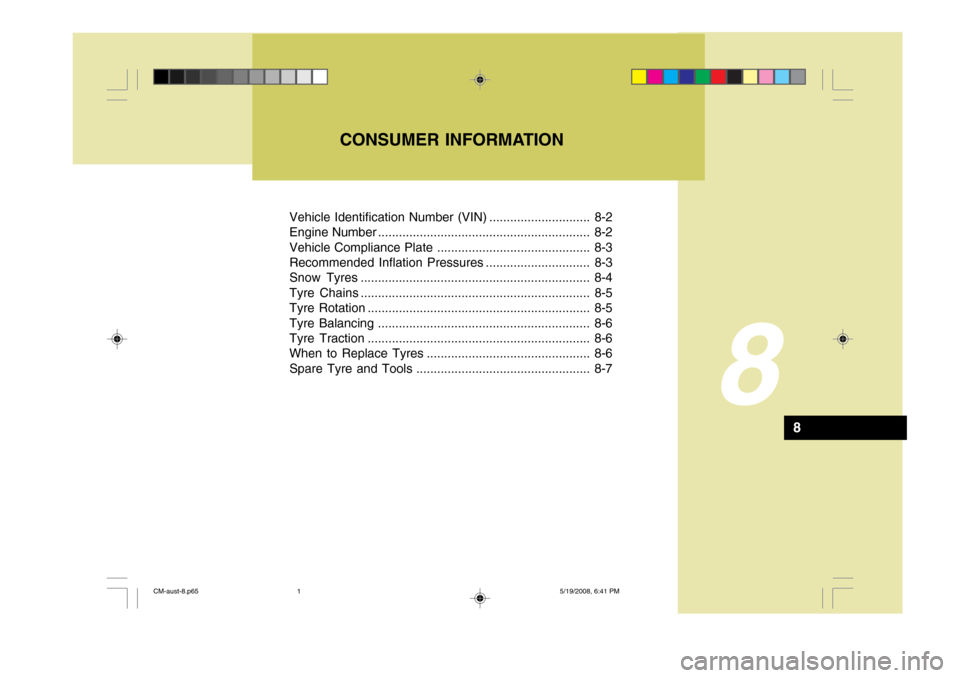
Vehicle Identification Number (VIN) ............................. 8-2
Engine Number ............................................................. 8-2
Vehicle Compliance Plate ............................................ 8-3
Recommended Inflation Pressures .............................. 8-3
Snow Tyres .................................................................. 8-4
Tyre Chains .................................................................. 8-5
Tyre Rotation ................................................................ 8-5
Tyre Balancing ............................................................. 8-6
Tyre Traction ................................................................ 8-6
When to Replace Tyres ............................................... 8-6
Spare Tyre and Tools .................................................. 8-7
8
CONSUMER INFORMATION
8
CM-aust-8.p655/19/2008, 6:41 PM
1
Page 254 of 269

8CONSUMER INFORMATION
2ENGINE NUMBERVEHICLE IDENTIFICATION NUMBER (VIN)
I010A01CM-DAT
The vehicle identification number (VIN) is the number used in registering your car and in all legal matters pertaining to its ownership, etc. It can be found inthree different places on your car:
1. On the engine side of the firewall
between the engine and driver com- partment.
2. On the left top side of the instru- ment panel where it can be seen bylooking down through the windshield.(If Installed)
3. Door edge post (Front passenger's
side).OCM056001R
OCM053107R
OCM056002
1
2
3I010B01A-AAT
OCM056003A
Petrol Engine 3.3 V6
Petrol Engine 2.7 V6
OCM056004N
CM-aust-8.p65 5/19/2008, 6:41 PM
2
Page 255 of 269
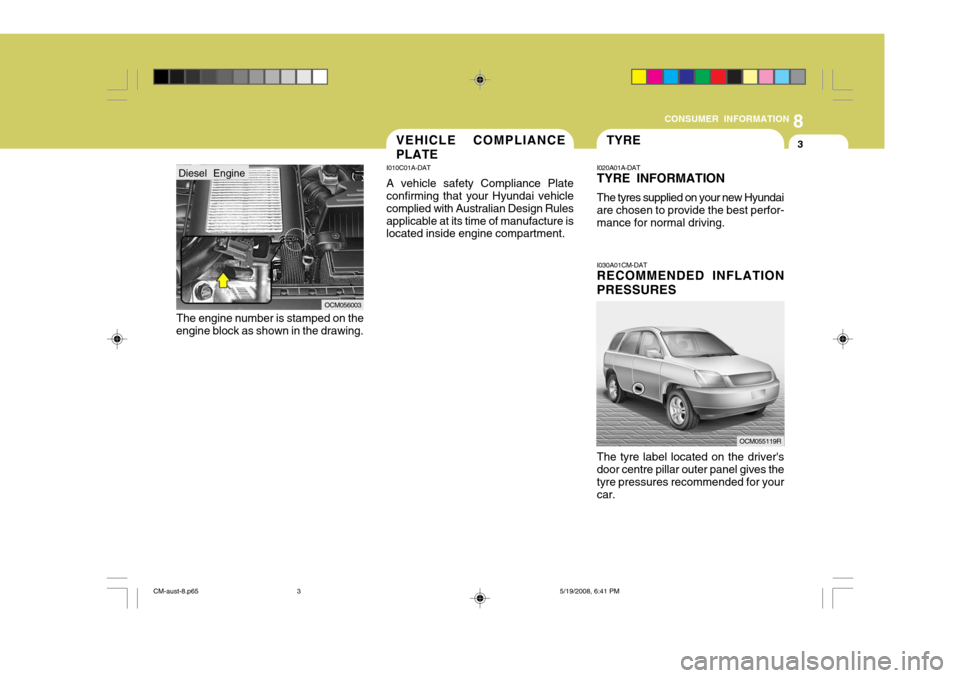
8
CONSUMER INFORMATION
3TYRE
I030A01CM-DAT RECOMMENDED INFLATION PRESSURES The tyre label located on the driver's door centre pillar outer panel gives the tyre pressures recommended for your car.
I020A01A-DAT TYRE INFORMATION The tyres supplied on your new Hyundai are chosen to provide the best perfor- mance for normal driving.
OCM055119R
I010C01A-DAT A vehicle safety Compliance Plate confirming that your Hyundai vehicle complied with Australian Design Rulesapplicable at its time of manufacture is located inside engine compartment.
VEHICLE COMPLIANCE PLATE
Diesel Engine
The engine number is stamped on the
engine block as shown in the drawing.
OCM056003
CM-aust-8.p65 5/19/2008, 6:41 PM
3
Page 256 of 269
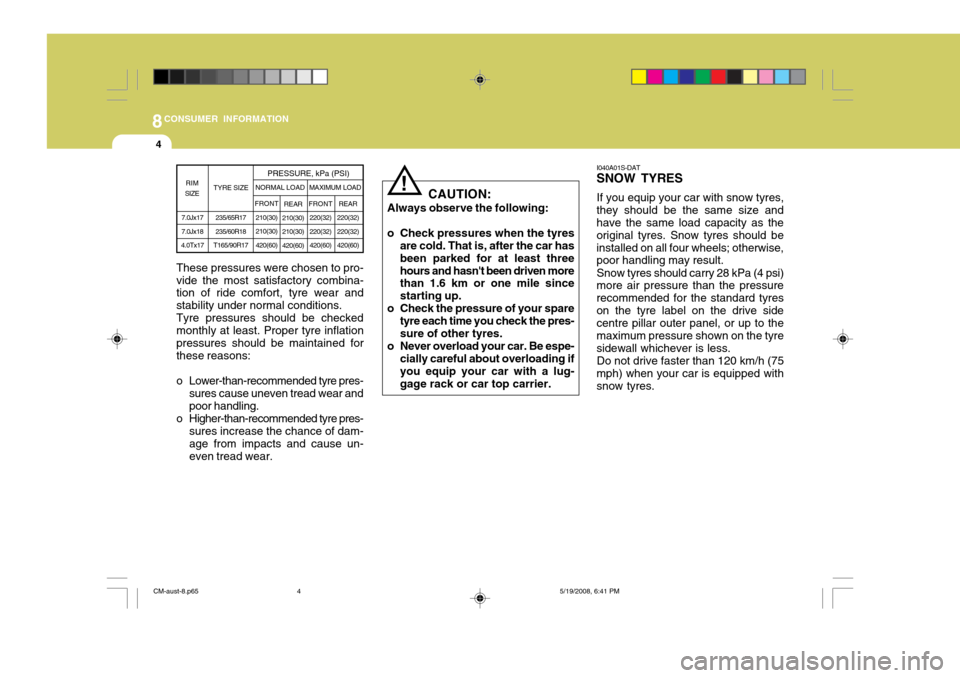
8CONSUMER INFORMATION
4
!
CAUTION:
Always observe the following:
o Check pressures when the tyres are cold. That is, after the car has been parked for at least threehours and hasn't been driven more than 1.6 km or one mile since starting up.
o Check the pressure of your spare tyre each time you check the pres-sure of other tyres.
o Never overload your car. Be espe- cially careful about overloading if you equip your car with a lug- gage rack or car top carrier. I040A01S-DAT
SNOW TYRES
If you equip your car with snow tyres,
they should be the same size and have the same load capacity as the original tyres. Snow tyres should beinstalled on all four wheels; otherwise, poor handling may result.
Snow tyres should carry 28 kPa (4 psi)
more air pressure than the pressure recommended for the standard tyreson the tyre label on the drive side centre pillar outer panel, or up to the maximum pressure shown on the tyresidewall whichever is less.
Do not drive faster than 120 km/h (75
mph) when your car is equipped withsnow tyres.
These pressures were chosen to pro-vide the most satisfactory combina- tion of ride comfort, tyre wear and stability under normal conditions.Tyre pressures should be checkedmonthly at least. Proper tyre inflationpressures should be maintained for these reasons:
o Lower-than-recommended tyre pres-
sures cause uneven tread wear and poor handling.
o Higher-than-recommended tyre pres-
sures increase the chance of dam- age from impacts and cause un- even tread wear.
7.0Jx17 7.0Jx18
4.0Tx17 TYRE SIZE
RIM
SIZE PRESSURE, kPa (PSI)
235/65R17235/60R18
T165/90R17 REAR
210(30)210(30)420(60) FRONT
220(32)220(32) 420(60)
NORMAL LOAD
MAXIMUM LOAD
REAR
220(32) 220(32) 420(60)
FRONT
210(30) 210(30)420(60)
CM-aust-8.p65 5/19/2008, 6:41 PM
4
Page 257 of 269

8
CONSUMER INFORMATION
5
!
!
Tyres should be rotated every 10,000
km (6,000 miles). If you notice that tyres are wearing unevenly between rotations, have the car checked by a Hyundai dealer so the cause may becorrected. After rotating, adjust the tyre pres-
sures and be sure to check wheel nuttorque.
I060A01FC-DAT
TYRE ROTATION
WARNING:
o Do not use the temporary spare tyre for tyre rotation.
o Do not mix bias-ply and radial- ply tyres under any circum-stances. This may cause dangerous han- dling characteristics that may cause death, serious injury, orproperty damage.
I050A01O-DAT
TYRE CHAINS
Tyre chains, if necessarly, should be
installed on all wheels. Be sure that the chains are the proper size and that they are installed in accordance withthe manufacturer's instructions. To minimise tyre and chain wear, do
not continue to use tyre chains when they are no longer needed.
WARNING:
o When driving on roads covered with snow or ice, drive at less than 30 km/h (20 mph).
o Use the SAE "S" class or wire &
plastic chains.
o If you have noise caused by chains contacting the body, re-tighten the chain to avoid contactwith the vehicle body.
o To prevent body damage, re- tighten the chains after driving 0.5~1 km (0.3~0.6 mile).
I060A01TG
I060A02TGSpare tyre
Temporary spare tyre type
Full size spare tyre type
CM-aust-8.p65 5/19/2008, 6:41 PM
5
Page 258 of 269
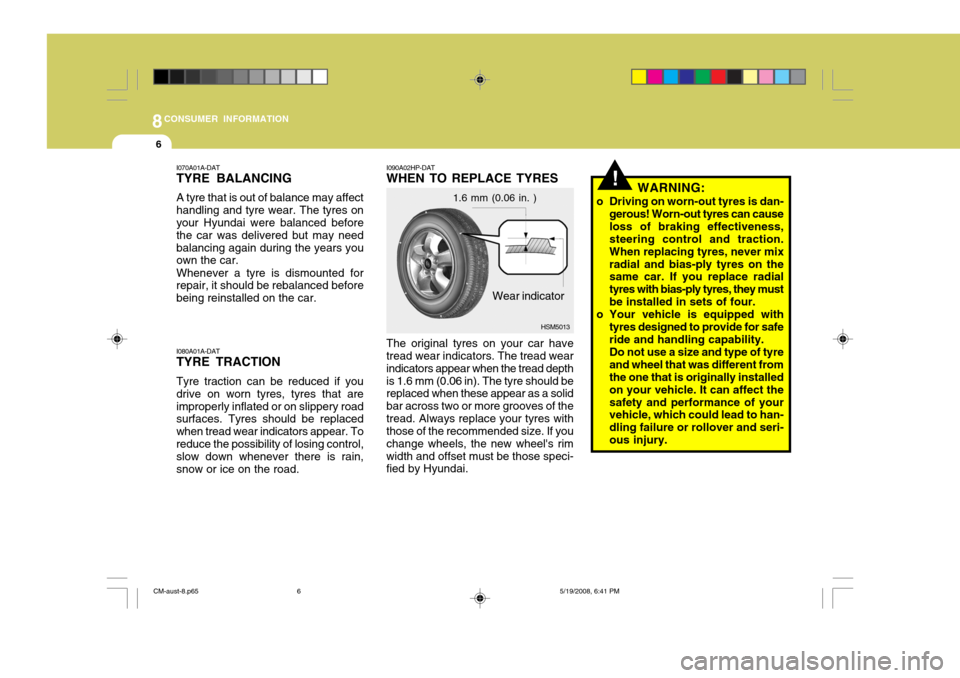
8CONSUMER INFORMATION
6
!
I090A02HP-DAT WHEN TO REPLACE TYRES The original tyres on your car have tread wear indicators. The tread wear indicators appear when the tread depthis 1.6 mm (0.06 in). The tyre should be replaced when these appear as a solid bar across two or more grooves of thetread. Always replace your tyres with those of the recommended size. If you change wheels, the new wheel's rimwidth and offset must be those speci- fied by Hyundai.
Wear indicator
1.6 mm (0.06 in. )
HSM5013 WARNING:
o Driving on worn-out tyres is dan- gerous! Worn-out tyres can cause loss of braking effectiveness, steering control and traction. When replacing tyres, never mixradial and bias-ply tyres on the same car. If you replace radial tyres with bias-ply tyres, they mustbe installed in sets of four.
o Your vehicle is equipped with tyres designed to provide for safe ride and handling capability. Do not use a size and type of tyre and wheel that was different from the one that is originally installed on your vehicle. It can affect thesafety and performance of your vehicle, which could lead to han- dling failure or rollover and seri-ous injury.
I070A01A-DAT TYRE BALANCING A tyre that is out of balance may affect handling and tyre wear. The tyres on your Hyundai were balanced before the car was delivered but may needbalancing again during the years you own the car. Whenever a tyre is dismounted for repair, it should be rebalanced before being reinstalled on the car. I080A01A-DAT TYRE TRACTION Tyre traction can be reduced if you drive on worn tyres, tyres that areimproperly inflated or on slippery road surfaces. Tyres should be replaced when tread wear indicators appear. Toreduce the possibility of losing control, slow down whenever there is rain, snow or ice on the road.
CM-aust-8.p65
5/19/2008, 6:41 PM
6
Page 259 of 269
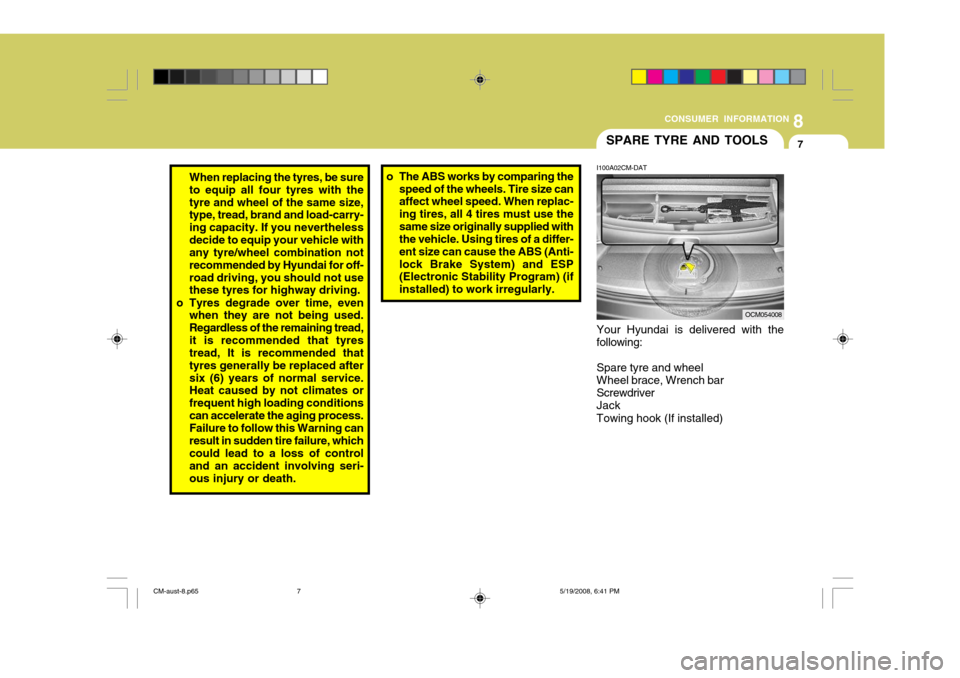
8
CONSUMER INFORMATION
7SPARE TYRE AND TOOLS
I100A02CM-DAT Your Hyundai is delivered with the following: Spare tyre and wheel Wheel brace, Wrench bar Screwdriver Jack Towing hook (If installed)
When replacing the tyres, be sure to equip all four tyres with thetyre and wheel of the same size, type, tread, brand and load-carry- ing capacity. If you neverthelessdecide to equip your vehicle with any tyre/wheel combination not recommended by Hyundai for off-road driving, you should not use these tyres for highway driving.
o Tyres degrade over time, even when they are not being used. Regardless of the remaining tread,it is recommended that tyres tread, It is recommended that tyres generally be replaced aftersix (6) years of normal service. Heat caused by not climates or frequent high loading conditionscan accelerate the aging process.Failure to follow this Warning canresult in sudden tire failure, which could lead to a loss of control and an accident involving seri-ous injury or death.
OCM054008
o The ABS works by comparing the
speed of the wheels. Tire size can affect wheel speed. When replac- ing tires, all 4 tires must use thesame size originally supplied with the vehicle. Using tires of a differ- ent size can cause the ABS (Anti-lock Brake System) and ESP (Electronic Stability Program) (if installed) to work irregularly.
CM-aust-8.p65 5/19/2008, 6:41 PM
7
Page 260 of 269
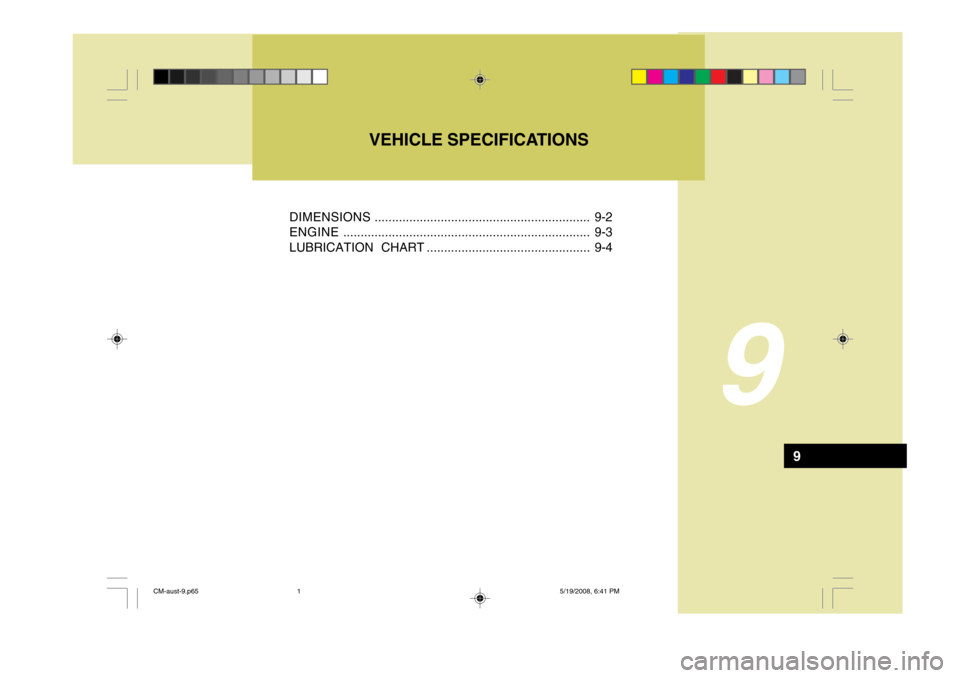
DIMENSIONS.............................................................. 9-2
ENGINE ....................................................................... 9-3
LUBRICATION CHART ............................................... 9-4
9
VEHICLE SPECIFICATIONS
9
CM-aust-9.p65 5/19/2008, 6:41 PM
1